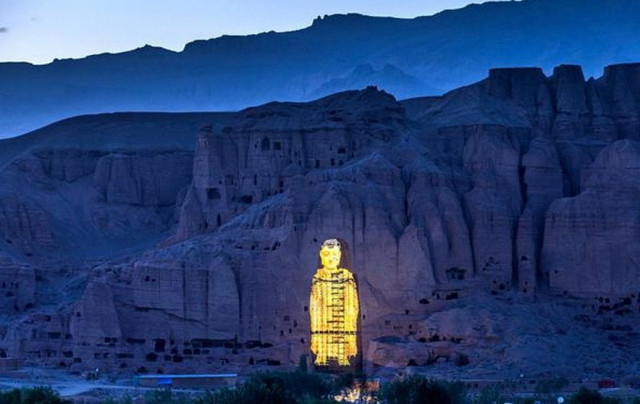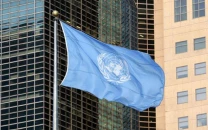Chinese couple bring destroyed Bamiyan Buddha statue back to 'light'
The couple also donated their projection equipment to Bamiyan, worth nearly $100,000

A view of the lit Bamiyan Statue in Afghanistan. PHOTO: COURTESY XINHUA
Using relics-friendly technology, Zhang Xinyu and Liang Hong were able to 'restore' the iconic statues for two days last weekend to the cheers from the locals.
Xinyu told Chinese news agency Xinhua that, along with his wife, they aimed to help the people of the area understand the significance of their cultural heritage.
Read: Bamiyan declared SAARC Cultural Capital 2015
"When I saw the smile on the people's face in Bamiyan, I knew what we had done was quite meaningful, not only for the Bamiyan people, but also for ourselves. We wanted to find a way to help the people there and showing the Buddha by image projection was the best we could do," Hong said.
"Many kids in Bamyan told me that they have never seen the Buddha. All they have seen was the huge hole where the Buddha used to be on the mountain side before it was blasted off by the Taliban."

Zhang Xinyu (L) and Liang Hong (R) use projection technology to bring the destroyed Bamiyan Buddha's back to 'light'. PHOTO: COURTESY XINHUA
The couple also donated their projection equipment to Bamiyan, worth nearly $100,000.
"We knew very little about Afghanistan before we came here. Our entire image of this strife-torn nation was merely about poverty and suicide attacks," Xinyu said.
Xinyu and Hong had arrived in Afghanistan in the beginning of June, as part of a 10-day multi-nation tour along the ancient Silk Road.
The two giant Buddhas were shattered to pieces with explosives by Taliban in 2001 despite appeals from the international community.
Bamiyan as Cultural Capital
Afghanistan’s ancient city of Bamiyan on Friday was officially declared as the cultural capital of the South Asian Association for Regional Cooperation (SAARC) for 2015, the spokesperson for Pakistan embassy in Afghanistan Akhtar Munir told The Express Tribune.
Munir and another diplomat Khurshid Marwat represented Pakistan at the ceremony held at the historic city of Bamiyan.
The declaration would provide an opportunity for Bamiyan to generate considerable cultural, social and economic benefits and could also abet urban regeneration, Afghan officials said.
It is pertinent to mention here that after the collapse of the Taliban in late 2001, Afghan government in coordination with international groups started a major reconstruction process at the site to be able to lure local and foreign visitors.
The Buddhas and Shahr-e-Ghulghula or "Screaming City" are among the eight cultural relics in the Bamyan Valley listed as world's cultural heritage by UNESCO in year 2003.
Read: German scientists eye Afghan Buddha reconstruction
But the volatile security situation in the country coupled with absence of tourism facilities has been keeping the tourists away.
Bamyan does not only possess the cultural relics but also has the country’s only national park called Band-e-Amir that makes it even more significant.
Needless to mention, if fully developed, tourism industry in Afghanistan can fetch up to five billion US dollars for the country in revenues each year, provided that tourists and their visited sites are provided with ample security and stability.
The article first appeared on Shanghai Daily



















COMMENTS
Comments are moderated and generally will be posted if they are on-topic and not abusive.
For more information, please see our Comments FAQ